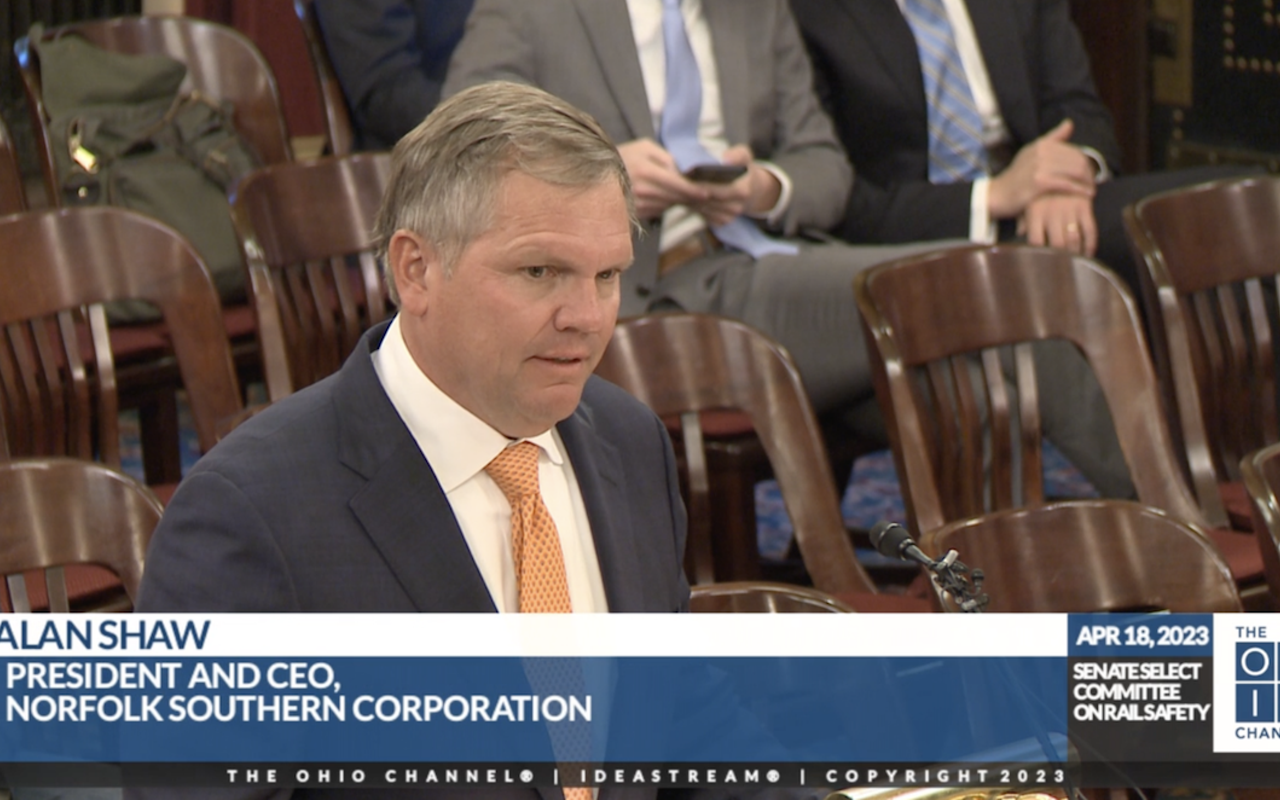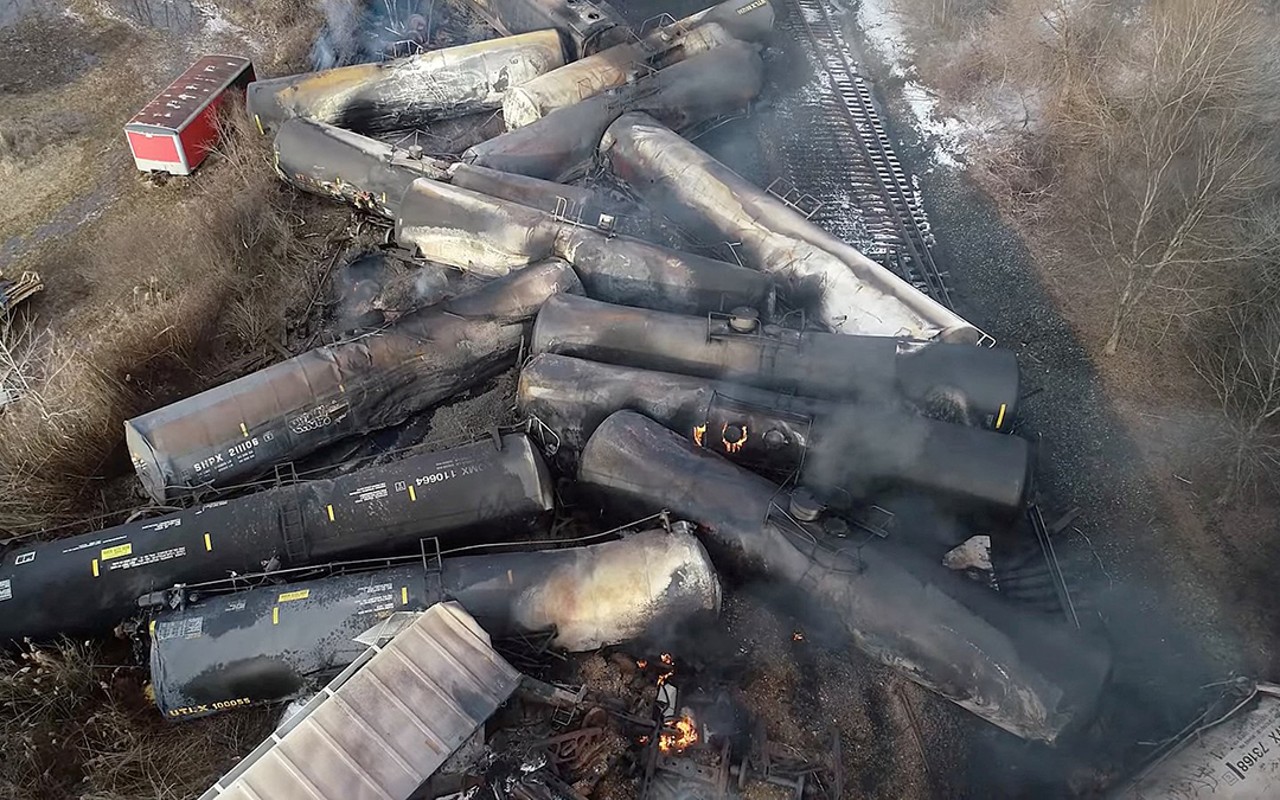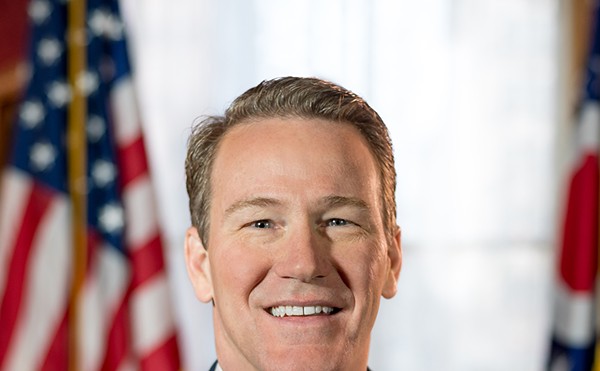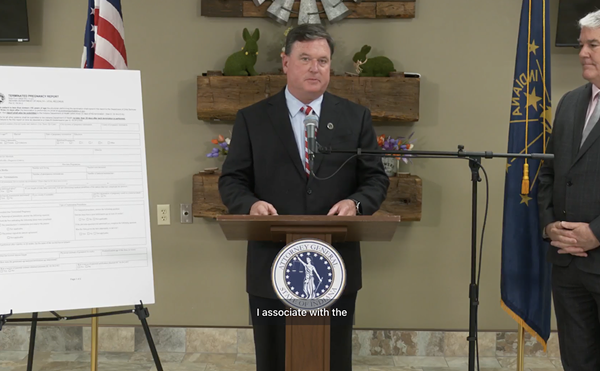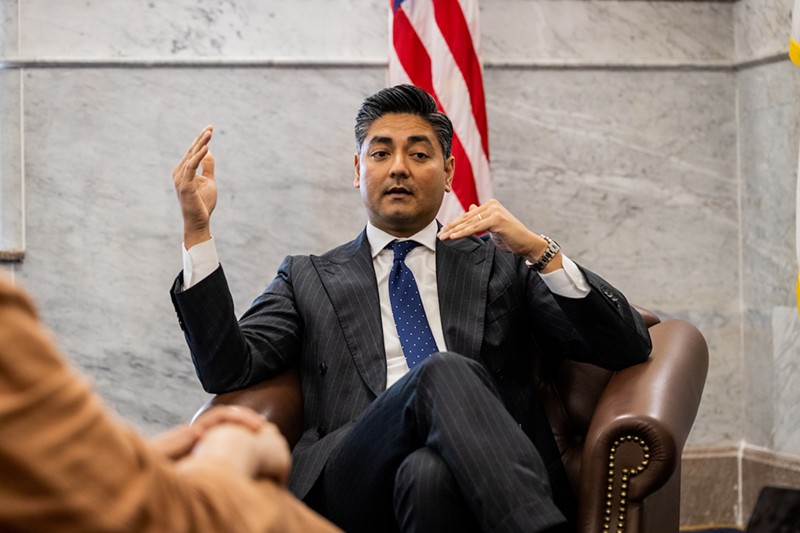
Photo: Emory Davis
Cincinnati Mayor Aftab Pureval sits down with CityBeat's Madeline Fening to talk about the proposed sale of the Cincinnati Southern Railway to problematic rail giant, Norfolk Southern.
It’s unclear when Cincinnati voters will be asked to decide whether or not to sell the Cincinnati Southern Railway to Norfolk Southern, but the choice is coming. After a train carrying hazardous chemicals derailed from its tracks in East Palestine on Feb. 3 (potentially caused by system neglect from the multi-billion dollar rail giant), a plume of thick black smoke painted a dark picture for the weeks to come. Days-long evacuations, scores of animals dead, anxiety and panic over the safety of the village’s drinking water; the East Palestine train derailment has been Ohio’s nationally defining story in early 2023, and Cincinnati is the spinoff.
The Cincinnati Southern Railway is a single rail line that starts in a sea of railroads at Queensgate Yard and ends in Chattanooga. The 336-mile commercial freight railway is the only city-owned multi-state railway in the country. Over the years, Cincinnati has leased the line to rail operator Cincinnati, New Orleans and Texas Pacific Railway (CNO&TP), a wholly-owned subsidiary of Norfolk Southern. The first lease agreement with CNO&TP was signed in 1881 and has been renewed on a 25-year cycle ever since. The latest lease agreement turns 25 this year, and Cincinnati Mayor Aftab Pureval wants Cincinnati to break up with the commercial rail industry in the form of a sale.
But voters have raised concerns about future safety if the city relinquishes ownership of its railway to the company that caused the fiery explosion of vinyl chloride in East Palestine. Pureval made the pitch to voters less than four months before the catastrophic train derailment, but four months after the crash, he sat down with CityBeat to give a renewed pitch post-East Palestine.
CityBeat: Thank you for sitting down with me to talk about this sale. To start out, what’s your elevator pitch to voters about why they should vote to sell the Cincinnati Southern Railway to Norfolk Southern, even after what we’ve seen in East Palestine?
Mayor Aftab Pureval: For the last 150 years we have leased the railroad to Norfolk Southern for its various entities, and the lease is a 25 year lease, that lease ends this year. The contract requires a negotiation of the lease in anticipation of the lease term ending, which the Cincinnati Railroad Board did. Over the last year they have negotiated aggressively in order to get the best possible deal with the city, both for a lease or for a sale. The parties are very very far apart on the lease terms. Norfolk Southern wants the $25 million that we get based on the most recent lease term to continue into the next 25 years. We want a significantly higher lease term. The parties were not able to close the gap on that lease term.
The financials
Mayor Aftab Pureval: For the last 150 years we have leased the railroad to Norfolk Southern for its various entities, and the lease is a 25 year lease, that lease ends this year. The contract requires a negotiation of the lease in anticipation of the lease term ending, which the Cincinnati Railroad Board did. Over the last year they have negotiated aggressively in order to get the best possible deal with the city, both for a lease or for a sale. The parties are very very far apart on the lease terms. Norfolk Southern wants the $25 million that we get based on the most recent lease term to continue into the next 25 years. We want a significantly higher lease term. The parties were not able to close the gap on that lease term.
Right now, the $25 million that we get from the lease all goes towards existing infrastructure, and despite that $25 million a year we get on top of our infrastructure budget, we still have a $300 million deficit that is growing every year. We cannot catch up to that growing deficit, we cannot catch up to doing the basic services that a city needs to provide unless we get a once-in-a-lifetime opportunity to shore up our city’s budget for infrastructure, not just right now, but into the future. By selling the railroad we will get a $1.6 billion trust fund to shore up our basic services for generations and we also get the benefit of getting out of a rail industry that is under-regulated, under-managed and risky. Certainly the environmental catastrophe that we’re seeing in East Palestine, no one here wants that and if we continue to hold on to this asset, we could be on the hook for liability if something like that happened here.
The financials
CB: So, if Norfolk Southern were to enter into a new lease agreement with the city of Cincinnati in 2051, it would be less than the annual $25 million we get now?
AP: It would be whatever the third party arbitrator decides. It would be much less compared to a sale. There’s a certain amount of risk involved letting it go to a third party arbitrator because we don’t know what they’re going to decide, but we know that it won’t be $50-70 million a year, which is conservatively what we would get with the sale of the railroad.
AP: It would be whatever the third party arbitrator decides. It would be much less compared to a sale. There’s a certain amount of risk involved letting it go to a third party arbitrator because we don’t know what they’re going to decide, but we know that it won’t be $50-70 million a year, which is conservatively what we would get with the sale of the railroad.
CB: The floor is, we get $25 million, which is what the current lease agreement amount is, how is it that we would get more?
AP: So, we would get $1.6 billion in a lump sum from Norfolk Southern to sell the railroad. I don’t trust future mayors or future city council members any more than anyone else does, so in order to safeguard that $1.6 billion, in order to safeguard it from becoming a slush fund for pet projects, we partnered with the state legislature in order for the sale to move forward. In order for voters in Cincinnati to even vote on selling the railroad, we had to get state law changed. And as a part of that state law we put very, very strict limitations on what that money can be used for, and it can only be used for infrastructure. And it’s exactly the same way we currently use the proceeds of the rail lease to exclusively go to infrastructure.
The other part of the questions is, well, how can we make sure that money will be there? Well, the $1.6 billion principal will not be touched. The $50-70 million we would get every year is based on interest that is accrued by the $1.6 billion principal. So when we invest the $1.6 billion we will only spend down on the interest that is accrued, and we are conservatively estimating that to be $50 to $70 million. Now, the city, even if it is a year where returns are less than that $50 to $70 [million], we still need a specific amount every year from the trust fund. We will get that minimum $25 million, irrespectively of what the returns are if it’s a down year, but for years that it’s an up year, if we get in excess of $50 to $70 [million], all of the returns will go back into the principal. Because the $1.6 billion principal will not be touched, except for in extreme circumstances, that $1.6 billion will be there forever, or in perpetuity. If the $1.6 billion is never touched it’s going to be producing interest, producing money, every year based on that principal investment to go towards infrastructure.
AP: So, we would get $1.6 billion in a lump sum from Norfolk Southern to sell the railroad. I don’t trust future mayors or future city council members any more than anyone else does, so in order to safeguard that $1.6 billion, in order to safeguard it from becoming a slush fund for pet projects, we partnered with the state legislature in order for the sale to move forward. In order for voters in Cincinnati to even vote on selling the railroad, we had to get state law changed. And as a part of that state law we put very, very strict limitations on what that money can be used for, and it can only be used for infrastructure. And it’s exactly the same way we currently use the proceeds of the rail lease to exclusively go to infrastructure.
The other part of the questions is, well, how can we make sure that money will be there? Well, the $1.6 billion principal will not be touched. The $50-70 million we would get every year is based on interest that is accrued by the $1.6 billion principal. So when we invest the $1.6 billion we will only spend down on the interest that is accrued, and we are conservatively estimating that to be $50 to $70 million. Now, the city, even if it is a year where returns are less than that $50 to $70 [million], we still need a specific amount every year from the trust fund. We will get that minimum $25 million, irrespectively of what the returns are if it’s a down year, but for years that it’s an up year, if we get in excess of $50 to $70 [million], all of the returns will go back into the principal. Because the $1.6 billion principal will not be touched, except for in extreme circumstances, that $1.6 billion will be there forever, or in perpetuity. If the $1.6 billion is never touched it’s going to be producing interest, producing money, every year based on that principal investment to go towards infrastructure.
CB: Does this mean we are essentially investing in Norfolk Southern?
AP: No, the Cincinnati Rail Board will hire investment experts to invest the dollars in various financial products that are safe and reliable, something like a mutual fund.
AP: No, the Cincinnati Rail Board will hire investment experts to invest the dollars in various financial products that are safe and reliable, something like a mutual fund.
CB: Can you paint a picture of what it would look like if this rail sale doesn’t pass? What are some of our options for filling these deficits if it doesn’t pass?
AP: If this doesn’t pass and our deferred capital maintenance continues to go up by hundreds of millions of dollars then we would no longer be able to maintain the infrastructure we have. Roads will no longer be able to be paved with regularity, potholes will continue to be a challenge. We wouldn’t be able to remove snow effectively and quickly. We’ll have to downsize the number of fire stations and police stations we have, which will have an impact on safety. We won’t be able to maintain the parks we have in our community. The basic blocking and tackling of running a city will no longer be affordable.
AP: If this doesn’t pass and our deferred capital maintenance continues to go up by hundreds of millions of dollars then we would no longer be able to maintain the infrastructure we have. Roads will no longer be able to be paved with regularity, potholes will continue to be a challenge. We wouldn’t be able to remove snow effectively and quickly. We’ll have to downsize the number of fire stations and police stations we have, which will have an impact on safety. We won’t be able to maintain the parks we have in our community. The basic blocking and tackling of running a city will no longer be affordable.
Safety
CB: I think a lot of the anxiety around selling the Cincinnati Southern Railway is about control, but owning the railway doesn’t necessarily mean that we are regulating Norfolk Southern, and selling doesn’t mean they are regulating it, so how do you plan to explain to voters who has the control here?
AP: The federal government has exclusive control over managing and regulating the railroad. Even though we currently own the railroad, we have no power to regulate what goes on the rails. We have no power to require rail companies to give us a heads up when they’re transporting hazardous material. The city has no power to regulate the railroad. So, even if we don’t sell the railroad, we’d have no power to prevent something like East Palestine from happening in Cincinnati. Only the federal government has that power.
AP: The federal government has exclusive control over managing and regulating the railroad. Even though we currently own the railroad, we have no power to regulate what goes on the rails. We have no power to require rail companies to give us a heads up when they’re transporting hazardous material. The city has no power to regulate the railroad. So, even if we don’t sell the railroad, we’d have no power to prevent something like East Palestine from happening in Cincinnati. Only the federal government has that power.
CB: Now, obviously, the federal government is who regulates the railroads, but Norfolk Southern is the one who has been lobbying against those regulations. At any point during the hours of the sale negotiation, was the discussion ever had about the lobbying that has been done against safety regulations? Or their Civil War-era brakes?
AP: The railroad board has the exclusive power to manage that relationship with Norfolk Southern, both the lease and/or the sale. In fact, the railroad board has to approve the sale before it can go to council for a vote, and then it goes on the ballot. So all the negotiations were handled by the railroad board. So that’s a good question for them to answer.
AP: The railroad board has the exclusive power to manage that relationship with Norfolk Southern, both the lease and/or the sale. In fact, the railroad board has to approve the sale before it can go to council for a vote, and then it goes on the ballot. So all the negotiations were handled by the railroad board. So that’s a good question for them to answer.
CB: About the state legislature’s changes, they made it so that the name Norfolk Southern has to appear on the ballot, with lawmakers citing concerns post-East Palestine. How do you feel about that change?
AP: Look, I supported all the state legislature changes that got put into place. I want a process that is transparent, that the voters understand what they’re voting on. It’s my responsibility to explain to the residents of Cincinnati what the facts are, the challenges that we’re facing, and why this sale is in the best interest of not just current Cincinnatians, but future Cincinnatians. So, I’m incredibly supportive and proud of the partnership that we have with Columbus.
AP: Look, I supported all the state legislature changes that got put into place. I want a process that is transparent, that the voters understand what they’re voting on. It’s my responsibility to explain to the residents of Cincinnati what the facts are, the challenges that we’re facing, and why this sale is in the best interest of not just current Cincinnatians, but future Cincinnatians. So, I’m incredibly supportive and proud of the partnership that we have with Columbus.
CB: Representatives at Norfolk Southern have only appeared in front of Cincinnati City Council post-East Palestine once, in front of the Budget and Finance Committee, and the conversation was focused strictly on the financial capabilities of Norfolk Southern to make good on their promise to buy the railway, even with the looming possibility they could be sued by East Palestine, the Environmental Protection Agency, etc. Is there a reason why Norfolk Southern has not appeared before city council beyond that to talk about safety?
AP: I think once the Southern Railroad Board meets and decides whether or not to move forward with the ballot, council will then have an opportunity to weigh in and has to take a vote. So to the extent that any testifying takes place, it will likely take place then. There is no other reason that Norfolk Southern hasn’t testified since the initial sale announcement. But I anticipate that we’ll be talking to Norfolk Southern closer to the actual date.
AP: I think once the Southern Railroad Board meets and decides whether or not to move forward with the ballot, council will then have an opportunity to weigh in and has to take a vote. So to the extent that any testifying takes place, it will likely take place then. There is no other reason that Norfolk Southern hasn’t testified since the initial sale announcement. But I anticipate that we’ll be talking to Norfolk Southern closer to the actual date.
Convincing voters
CB: When the proposed sale was announced in 2022, most people were finding out we owned our own railroad for the first time, and maybe thinking we don’t want to sell something that’s so special. Once East Palestine happened, the conversation made a sudden pivot towards safety. People then assumed Norfolk Southern would now control our railway. I asked CityBeat’s readers on Twitter and Instagram if they plan to vote in favor of the sale. On Twitter, 51% voted no, 22% voted yes and 25% were unsure. On Instagram, 61% voted no, 9% voted yes and 30% voted unsure. What is your reaction to those numbers?
AP: My reaction is, well, for me the choice is very clear. I am staring down a fiscal situation that is dire with the city not being able to provide basic services that citizens desire. We’re facing a rail industry that puts the city at risk for owning a railroad that the federal government has the exclusive power to manage and regulate, and we’re looking at a sale that could solve both issues. It takes Cincinnati out of the risky liability of owning a railroad, given the derailments that keep happening, and number two, we get an opportunity to secure our fiscal future.
AP: My reaction is, well, for me the choice is very clear. I am staring down a fiscal situation that is dire with the city not being able to provide basic services that citizens desire. We’re facing a rail industry that puts the city at risk for owning a railroad that the federal government has the exclusive power to manage and regulate, and we’re looking at a sale that could solve both issues. It takes Cincinnati out of the risky liability of owning a railroad, given the derailments that keep happening, and number two, we get an opportunity to secure our fiscal future.
CB: Since East Palestine, the public image of Norfolk Southern and what they gain on their end of the sale has shifted a lot. What level of responsibility do you think Norfolk Southern has to convince voters that this sale is a good idea?
AP: [Inhales and pauses] Um, you know I think it’s really up to me and city leadership to tell the story, to tell the facts, and to persuade people that this is in the best interest of the city. I guess you have to ask Norfolk Southern about their view of their role in it, but, I really do view it as my role as mayor to explain to folks a relatively complex issue. Why, despite its complexity, it is in everyone’s best interest for the sale. I see that more as my responsibility.
AP: [Inhales and pauses] Um, you know I think it’s really up to me and city leadership to tell the story, to tell the facts, and to persuade people that this is in the best interest of the city. I guess you have to ask Norfolk Southern about their view of their role in it, but, I really do view it as my role as mayor to explain to folks a relatively complex issue. Why, despite its complexity, it is in everyone’s best interest for the sale. I see that more as my responsibility.
CB: I think that the idea of us selling our railway to Norfolk Southern makes it sound to voters that we are partnering with the company, or perhaps deepening a partnership with them.
AP: Just the opposite. We’re separating from Norfolk Southern entirely. So after this, it’s either having another 25 year relationship with Norfolk Southern, or it’s separating entirely and, not only shoring up our litigation liability, but also getting $1.6 billion dollars to shore up our finances.
AP: Just the opposite. We’re separating from Norfolk Southern entirely. So after this, it’s either having another 25 year relationship with Norfolk Southern, or it’s separating entirely and, not only shoring up our litigation liability, but also getting $1.6 billion dollars to shore up our finances.
CB: What is that campaign messaging going to look like? Are you envisioning yard signs with trains on them? Public forums? What’s the plan?
AP: We’re envisioning a full-on campaign. For my part, I can say that I’ll be making myself available as much as possible through town halls, through meeting interviews, through community events, explaining the issue, and persuading people that selling the railroad is in the best interest of the city, and doing everything I can to educate and inform, but also ultimately persuade.
AP: We’re envisioning a full-on campaign. For my part, I can say that I’ll be making myself available as much as possible through town halls, through meeting interviews, through community events, explaining the issue, and persuading people that selling the railroad is in the best interest of the city, and doing everything I can to educate and inform, but also ultimately persuade.
CB: How can you do that without damning Norfolk Southern while also not making it sound like the city and Norfolk Southern are cozy?
AP: Yeah, I mean, that’s a good question. I understand your perspective about why that might be difficult, but the truth of the matter is really simple. I don’t want Cincinnati to have anything to do with the railway industry. I don't want them to have anything to do with the rail carriers, I don't want us to have anything to do with the rail line. There’s so much uncertainty, there’s so much risk. So it really is separating entirely from not just Norfolk Southern, but really from the railway industry, or at least the commercial rail industry as a whole. But on top of that, we also get $1.6 billion to fill a fiscal hole that really does threaten the future of our city. So from my perspective it’s a clear win-win.
AP: Yeah, I mean, that’s a good question. I understand your perspective about why that might be difficult, but the truth of the matter is really simple. I don’t want Cincinnati to have anything to do with the railway industry. I don't want them to have anything to do with the rail carriers, I don't want us to have anything to do with the rail line. There’s so much uncertainty, there’s so much risk. So it really is separating entirely from not just Norfolk Southern, but really from the railway industry, or at least the commercial rail industry as a whole. But on top of that, we also get $1.6 billion to fill a fiscal hole that really does threaten the future of our city. So from my perspective it’s a clear win-win.
CB: In most campaigns, usually the messaging around what you’re selling to voters comes from a place of passion and storytelling, but with something like this, it sounds like you need to sell it to people in a stone-cold facts kind of way. Is that the plan?
AP: I think the storytelling is twofold. Number one, the storytelling of protecting Cincinnati from the rail industry, I think is part of it. The second part of it is painting in people's minds a future of Cincinnati that has incredible parks and incredible rec centers that can help particularly in the summer months with our CPS students not in school, making sure they’re doing something productive and healthy with their time, our police and fire stations, to make sure that public safety continues to be a priority. And then just the ability for people to get in and around our city with good public transportation, good roads and bridges, and you know, frankly being able to just plow the snow. I mean, painting that picture of what a modern thriving, prosperous, growing Cincinnati looks like is directly relevant to whether or not we get this thing passed.
AP: I think the storytelling is twofold. Number one, the storytelling of protecting Cincinnati from the rail industry, I think is part of it. The second part of it is painting in people's minds a future of Cincinnati that has incredible parks and incredible rec centers that can help particularly in the summer months with our CPS students not in school, making sure they’re doing something productive and healthy with their time, our police and fire stations, to make sure that public safety continues to be a priority. And then just the ability for people to get in and around our city with good public transportation, good roads and bridges, and you know, frankly being able to just plow the snow. I mean, painting that picture of what a modern thriving, prosperous, growing Cincinnati looks like is directly relevant to whether or not we get this thing passed.
Other options
CB: Why can’t we just do this with someone else? There’s other players, CSX?
AP: It’s multifaceted. It could be someone else, but again, it goes back to the lease terms, which are very favorable towards Norfolk Southern. In addition to a third party arbitrator having to weigh in, having the authority to weigh in, if the parties can’t agree on the lease terms, Norfolk Southern also has the right to a first refusal.
AP: It’s multifaceted. It could be someone else, but again, it goes back to the lease terms, which are very favorable towards Norfolk Southern. In addition to a third party arbitrator having to weigh in, having the authority to weigh in, if the parties can’t agree on the lease terms, Norfolk Southern also has the right to a first refusal.
So they have the right to match any option coming from a third party. But more to the point - the reason why Norfolk Southern is in the best possible position to give us the most money to value our railroad the most, or the highest, is because the network leading into the northern part of our railroad is all owned by Norfolk Southern, and the network leading out of the southern end of our railroad is also owned by Norfolk Southern. So they’re really in the best possible position to value our railroad segment the highest in the open market, and on top of that, they also have the right to first refusal and release.
CB: How will this impact the city’s ability to expand passenger rail travel?
AP: Cincinnati is really leading the way to advocate for Amtrak’s grants. That will open up huge possibilities for us, not just within Ohio, but via Indiana to Chicago along the Cardinal line. None of the non-passenger rail conversations that we’re having will have a negative impact on the passenger rail, and that is a big priority for the city.
AP: Cincinnati is really leading the way to advocate for Amtrak’s grants. That will open up huge possibilities for us, not just within Ohio, but via Indiana to Chicago along the Cardinal line. None of the non-passenger rail conversations that we’re having will have a negative impact on the passenger rail, and that is a big priority for the city.
CB: As you said when you first sat down, Cincinnati has owned its own railway for a very long time. For so long it was an asset, it was positive, a strength. At what point in our history did it shift from a strength to a liability? From a good thing to bad?
AP: I think the most recent instance of the East Palestine environmental and human catastrophe that continues to unfold, was certainly a large event that made people reconsider the liabilities that’s associated with owning a railroad. So I think that most recently was the biggest instance of that. But I will say, since that catastrophe has occurred and continues to occur, we see almost on a daily basis, headlines from railcars that are derailing, or accidents that are happening, or deaths that are happening. Not just here in Ohio but around the country.
AP: I think the most recent instance of the East Palestine environmental and human catastrophe that continues to unfold, was certainly a large event that made people reconsider the liabilities that’s associated with owning a railroad. So I think that most recently was the biggest instance of that. But I will say, since that catastrophe has occurred and continues to occur, we see almost on a daily basis, headlines from railcars that are derailing, or accidents that are happening, or deaths that are happening. Not just here in Ohio but around the country.
If people don't want the city of Cincinnati having anything to do with Norfolk Southern, then they should vote for the sale. Because the sale of the railroad separates us entirely from Norfolk Southern and its business. If they vote against the sale, they’re forcing the city into a relationship with Norfolk Southern for at least another 25 years.
Follow CityBeat's staff news writer Madeline Fening on Twitter and Instagram.
Subscribe to CityBeat newsletters.
Follow us: Apple News | Google News | NewsBreak | Reddit | Instagram | Facebook | Twitter | Or sign up for our RSS Feed


